
Six to eight months ago SkyHawk Group burst on to the computer enclosure market with a series of low-end aluminium tower cases. Since then, it has been busy developing a line of 'mini-server' cases designed for the more demanding needs of high-powered hot running Athlon systems. Our hardware site - Amdmb.com - was one of the first to get its hands on one of these cases - the standard-bearer MSR4610EP-D.
It is my understanding that the MSR series will be made up of three models with up to six variations each, depending on the front port combinations or lack thereof. SkyHawk also provides a long list of options for its mini-server line of cases, including power supplies.
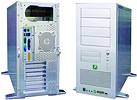
Specs and features
The only thing 'mini' about the SkyHawk MSR4610EP-D is its name. The dimensions are 490 (D) x 442 (H) x 208 (W) mm and it weighs a mere 5,45 kg. The chassis is anodised aluminum alloy which means it is nonmagnetic, as well as corrosion and oxidation resistant - the outside finish is brushed aluminum. Its capacity includes four external 5,25" drive bays; two external 3,5" drive bays, one hidden 3,5" drive bay and a hard drive rackmounted to the floor of the case for up to three 3,5" hard drives. The MSR4610EP-D is equipped with three 80 mm fans and unusually; the fans have ball bearing mechanisms instead of sleeve bearings. The 2500 rpm fans produce 30,95 CFMs each at a noise level of 29 dBA each (a 35 dBA combined rough estimate).
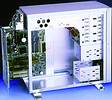
There are three screws on the side of the case bezel, they are used to hold in place a plastic liner that is fitted to the inside of the aluminum bezel, strengthening the bezel assembly. There really is no need to remove the front bezel, unless like me, you want to see what is under it! With the front bezel off the only points of interest are horizontally placed dual 80 mm fans with guards (Figure 3). I would have preferred intake filters instead of the fan guards. For obvious reasons (preventing dust particles from entering the computer). Also note that the plastic metallised feet of the case can be turned 90°, so that they are completely hidden, making it easy to fit the MSR4610EP-D in a tight work space.
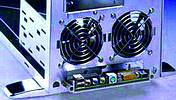
Like many of the newer cases available, the SkyHawk mini-server has front access connectors (Figure 4), but unlike other manufacturers this company offers a number of variations of this.

Inside the case
Figure 5 shows a view into the case with the motherboard tray removed. Here you can see the drive bays including the hidden 3,5" bay, the horizontally placed fans and the hard drive rackmounted to the floor of the case.
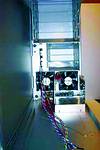
Notice the positioning; the hard drive rack is directly in front of the fan on the right and for good reason. Other cases have had the rack centred between the fans. This causes some deflection of the airflow preventing the maximum utilisation of the airflow generated by the two fans. With the Sky Hawk set-up, air is allowed to blow through the rack cooling the hard drive while the left fan's airflow is not obstructed. Around the power supply bracket towards the front of the case, is a horizontal bar. This serves two functions, it is firstly a stabilising bar and secondly its purpose is as a power supply support. This is just one of the many examples of why I loved this case; everything in it has a logical purpose with many having more than one.
One of the real pleasures to be found in better cases is a removable motherboard tray. Here, the mini-server is no exception, but it is taken one step further, with the addition of a support bracket to help maintain the tray's rigidity (Figure 6). This prevents the back panel from bending outwards from the tray with repeated use. Another feature is the standard use of brass standoffs for motherboard installation.
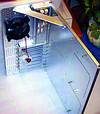
This pretty well covers the entire case, but there are still a few items, including the front panel wiring. Figure 7 shows the wiring harness used to connect to the front ports of the computer (a cable with a black connector on one end and a slot plate on the other). The uppermost cable connects to the slot connector and then to your ATX connectors on the outside of the case (back of case). One can choose to use them all or just those that you want front panel access to. I connected the USB, the Firewire and the Joystick ports, as I had no reason to connect the sound ports. The Joystick port on the front panel really comes in handy. Also, a neat little addition is a little connector that lets you convert a three-pin Power LED case connector to a two-pin connector - as required on some motherboards!
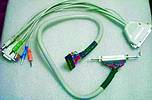
Conclusion
It was a real pleasure being able to review the SkyHawk Mini Server MSR4610EP-D. Michael Shen of Sky Hawk Computers has listened to me rant about what makes a good case for months and it is gratifying to see many of the things talked about incorporated in the mini-server line. This is definitely a company that listens to the wants and needs of computer users! There are a couple of areas we would like to see addressed and the first is the lack of an intake filter for the front fans; and the second is the case grill work in back of the exhaust fan (two perennial complaints with most cases). I believe the MSR4610EP-D is a reasonably priced aluminium case, as aluminium cases go, so contact your reseller.
For further information contact Pyramid PC-Technic, (011) 974 8996, [email protected]

© Technews Publishing (Pty) Ltd | All Rights Reserved